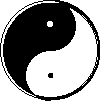 T'ai
Chi Collection
T'ai
Chi Collection Author Mike Sigman to neijia list on 11 Apr 1995
There is a comment attributed to Yang Cheng Fu which says, in effect, that when you do push-hands the hands don't move.
This is excellent advice and it goes hand-in-hand with the way the body is move in the form, etc. In other words, the power which is expressed in the hands and arms is the ground strength which has been propagated through the body (along the peng path) and which is directed by the waist.
When learning to do push-hands, the hands should be roughly in front of the body centerline and should not move from there. If they are moving in relation to the centerline, you are most probably using local strength and are therefore not using the correct internal strength.
Of course, as your skills progress, the movements will begin to revert to normal appearance (i.e., the hands will move in relation to the centerline), but the presence of the peng strength will be obvious upon feeling the arms.
I don't care how many forms someone knows or how traditional their style or how many tournaments they've won, etc., when I feel the arms being manipulated by normal shoulder and arm muscles, I know that there is a basic error. Until this basic error is corrected, it is useless to discuss high-level techniques.
I know that I have given my personal opinions on many things, but this one facet of development need to be framed and adhered to. I know of very many nationally known masters whose level is not obove this one big error. I know one Chinese master of many arts whose push-hands betrays his low level because of this very fact..... yet he is famous for telling other teachers that they don't really understand taiji. :^)
In a sense, you could say that all this relates to is the idea of practicing large circles before you try to practice small circles. If you try to start with small circles (i.e., your internal movements cannot be seen), there is a very strong probability that you will mistakenly do local movement with the belief that you are using internal strength.
Also, the cursory test that I mentioned in which I have someone put their hand on me and try to hit me without hand or shoulder motion is essentially a quick look at whether someone can really use the ground-strength and waist (internal strength) or whether they talk taiji but really use stance and shoulder to accomplish arm movement.
Hope this helps.
Regards,
Mike Sigman
 T'ai
Chi Collection
T'ai
Chi Collection |
Sponsor |